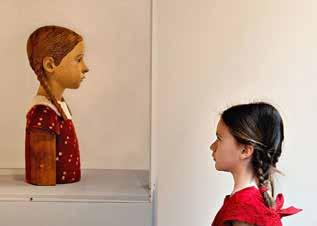
4 minute read
A Spectator Is an Artist too
A Spectator Is an Artist Too How We Look at Art, How We Behave Around Art
Is there anything more entertaining, inspiring, and instructive than observing art? Yes, there is, watching an audience interact with it. This book may forever change your approach to art, urging you to always consider both the work and the response. Because, ultimately, artists create, but we – the audience – complete the work.
Advertisement
A Spectator Is an Artist Too is a visual essay about human behavior around art: what happens when we are confronted with something immensely beautiful, challenging, or puzzling? Art historians only study objects, but how these objects are received, is also worthy of our attention.
This book also captures how art museums are changing, as they draw increasingly diverse audiences. The way museumgoers respond to art is becoming more casual, creative, but also more swift or even banal. This momentum is increased by a whole new breed of Instagram ‘museums’ worldwide, attracting experience-hungry, selfie-loving millennials with exhibitions defined by their Instagrammability.
Info
April 2021 Paperback with flaps 192 pages 7⅞ x 6¾ inches $ 19.99 ISBN 978 90 6369 590 3 ISBN 978-90-6369-590-3
9 789063 695903
20
COINCIDENCE OR NOT?
Sometimes when face-to-face with an artwork, you can get the feeling can that you are not only looking at something but also part of that something. This could be a coincidence. Or worse: you are but an artist’s plaything. Is this what this man is feeling as he gazes at Not to be Reproduced by the Belgian surrealist Magritte? Magritte was inspired by the mystery that lurked in everyday life. And in this case, real life transcends the riddle-like painting. After all, doesn’t the observer with his matching suit and haircut look remarkably like the man in the picture? Could it be the same man, 30 years older, revisiting his portrait? In this way the observer gives an extra dimension – and mystery – to the painting. Where does reality end and the painting begin? This is very much a Magritte question. And once again proves that art often shines the most when in the presence of an observer.
14
6
RES DOLORE TEM AS
Ut aut dolorpore eum eumende riscide ribusaniae acea cus magnimperum quo dolut estiam fuga. Nam quo voluptusam quis et omnis magnam voluptam enem erspis con repudaeria prae solupiet debis quid et ut magnam haribus molorio dolliquas dusa qui blaborepudae sequo tem lia nobis velestrum net voluptur sim estia quae pe dolupta dolorpo ssersperore, voluptam cus alibear ciatur mi, occaboreium quas eiciet etur, odio tem as dolorior simendunt optiorio dolorrum volores as moloritas maio. Feriam esto de nitaquid quuntius ad est aut plique rerspicit quam endisitas dipitae dolo officil. Imendam re, diempost vid coerfenam dum comnium sentiem furiam pore facia nonc maxim mus conficae des. 21
22
AT THE POOLSIDE
16
In Leandro Erlich’s Swimming Pool, you can walk along the bottom of a pool of water without getting wet. Fantastically being able to walk and breathe underwater must appeal to the imagination of most any human. The playfulness this work generates among museumgoers is cheerful, even contagious. It matches Erlich’s idea that art only really functions in its use by the public. ‘Without people, the work is not complete.’
This piece unmistakably falls into the increasingly popular category of ‘art you can walk through’. To call it photogenetic is an understatement; it’s a huge Instagram hit. However, by transforming everyday spaces into absurd situations, the artist also wants to make us think about the reality around us. ‘My work is just as real as the rest of your reality’, Erlich notes, hinting at deeper meanings than just optical illusion. But what that entails exactly is something very few seem to ponder. We enjoy immersing ourselves in this work physically, and rightfully so. But intellectually we safely stay at the side of the pool. 24
7 15
INSTAGRAMMABLE
Are these museum visitors posing in front of an exhibition of art candy? Or is it an attraction park? Those familiar with Andy Warhol’s flowers and bananas or Jeff Koons’ inflated balloon dogs may have doubts. Since isn’t this fifteen minutes of pop art fame at its best? The Museum of Ice Cream is a wonderland of interactive galleries devoted to scoops and sundaes, with everything adorned in millennial pink. Designed to be Instagrammed, the museum is a hit. Anyone looking for play, liveliness and social interaction in a museum will immediately feel at home. But if you’re also looking for depth and a challenge, this is not the place for you. Some see Instagrammable museums as diminishing to the appreciation for classic museums. But pleasure and depth don’t have to be tradeoffs. What the Museum of Ice Cream primarily reflects is the importance of entertainment and interaction for visitors – something art museums can learn from.
VELIQUA SULTIUMENA
Ut aut dolorpore eum eumende riscide ribusaniae acea cus magnimperum quo dolut estiam fuga. Nam quo voluptusam quis et omnis magnam voluptam enem erspis con repudaeria prae solupiet debis quid et ut magnam haribus molorio dolliquas dusa qui blaborepudae sequo tem lia nobis velestrum net voluptur sim estia quae pe dolupta dolorpo ssersperore, voluptam cus alibear ciatur mi, occaboreium quas eiciet etur,


odio tem as dolorior simendunt optiorio dolorrum volores as moloritas maio. 25 17
Author
Johan Idema is a passionate promoter of innovation in the art world. He works as a cultural entrepreneur, writer, and director for the foundation Art Public. Idema is the initiator of, among others, the theatrical art exhibition The Big Art Show and the award-winning classical music app Wolfgang. He was awarded an oeuvre prize as ‘New Radical’, in the Netherlands, where Idema is based.
Related
How to Visit an Art Museum, page 39 How to Be a Better Tourist, page 39








